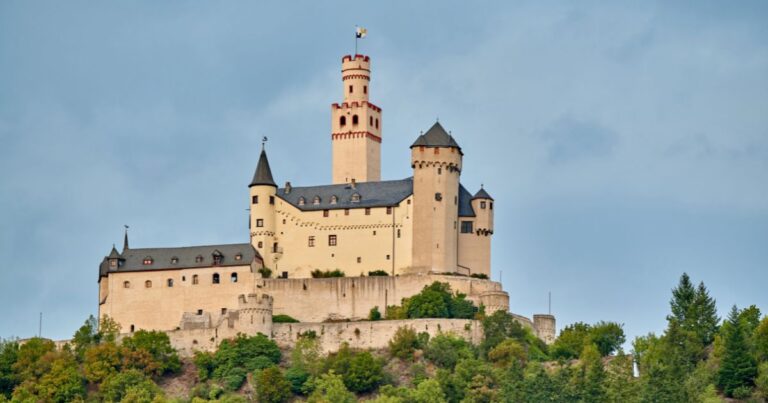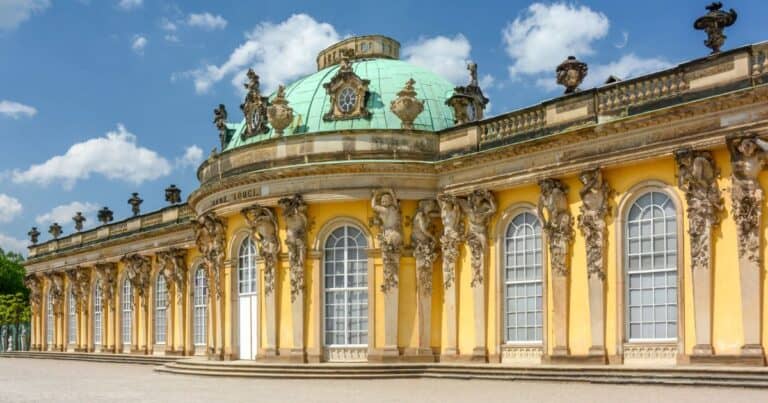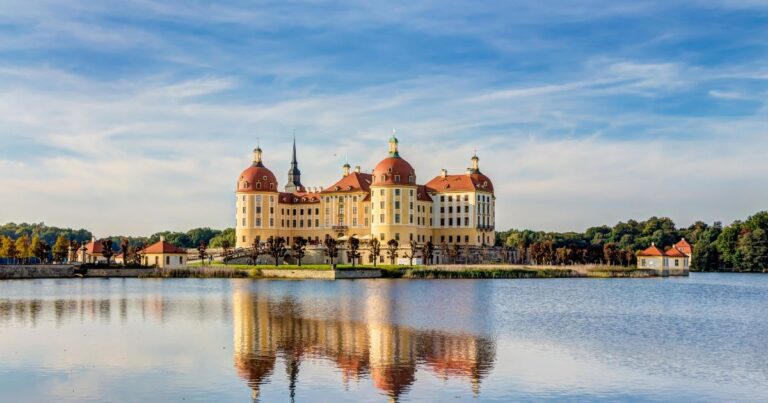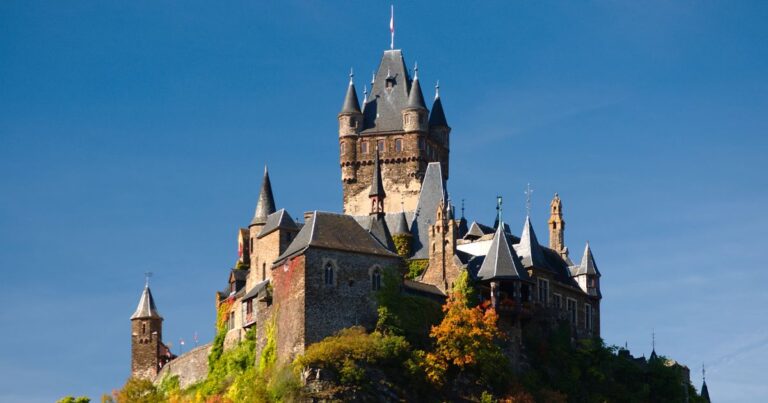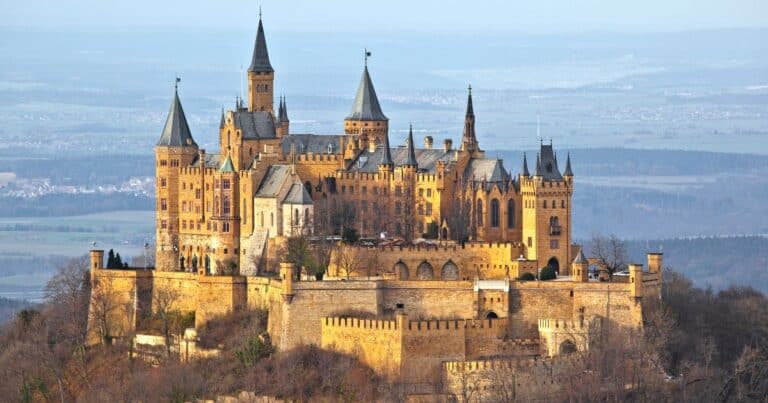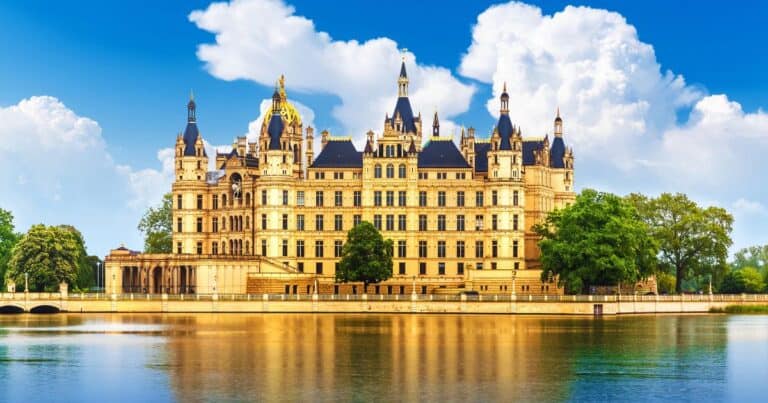Castles in Germany: Discover the Best German Castles & Palaces
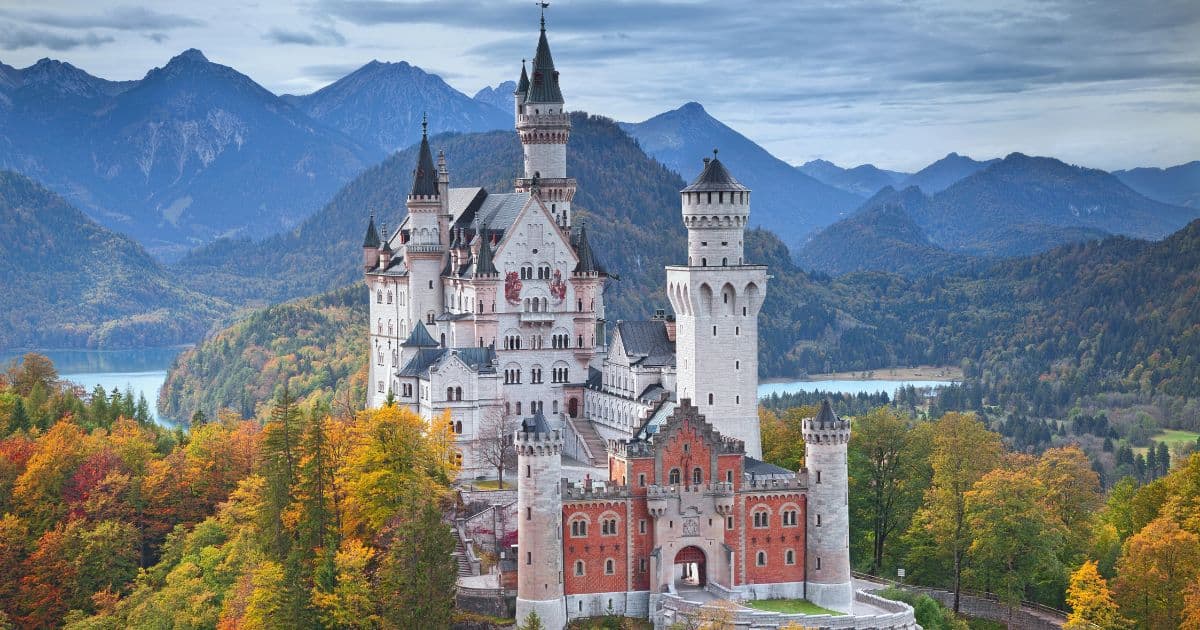
Germany is a dream destination for anyone fascinated by castles – and with good reason. With more than 20,000 castles in Germany, ranging from rugged medieval fortresses to opulent royal palaces, no other country in Europe offers such a diverse and breathtaking collection of historic estates. Whether you’re tracing the Rhine’s legendary strongholds, wandering Bavaria’s fairy-tale palaces, or strolling the Enlightenment gardens of Potsdam, exploring the castles in Germany is like stepping into a thousand years of European history.
With more than 40 years in the travel industry and decades spent exploring Europe’s historic estates, fortresses, and UNESCO World Heritage sites, I’ve visited German castles from the Alps to the Baltic coast. This guide gathers the essential history, architecture, regions, and must-see castles to help you plan unforgettable castle-themed travels across Germany.
Whether you’re here for dramatic ruins, opulent royal palaces, authentic medieval interiors, or simply those postcard-worthy views over the Rhine – this guide is your starting point.
Key Takeaways
- Germany has over 20,000 castles, palaces, and manor houses, more than any country in Europe.
- Each region features its own architectural style — Bavarian fairy-tale palaces, Gothic fortresses, Prussian summer residences, and Rhine Valley medieval strongholds.
- Several German castles still contain original furnishings, making them ideal for travelers who want authentic historic interiors.
- Many castles host museums, gardens, restaurants, cultural events, and walking trails.
- Germany’s castles are spread across multiple regions — it’s best to focus your visit around a specific valley, city, or state.
Historical Overview of Castles in Germany
Castles in Germany didn’t appear all at once – they developed over more than a millennium, each era leaving its architectural imprint.
Early Medieval Fortresses (10th–13th centuries)
This was Germany’s castle-building boom. Rival princes, bishops, and regional lords erected stone fortresses to control trade routes, protect valleys, and display power.
Common features:
- Square or round bergfrieds (keeps)
- Basic curtain walls
- Few windows (security first!)
- Steep hilltop positions for defense
Many early castles were small and fiercely utilitarian.
Examples:
Wartburg Castle • Marksburg Castle • Kyffhausen Castle (ruins)
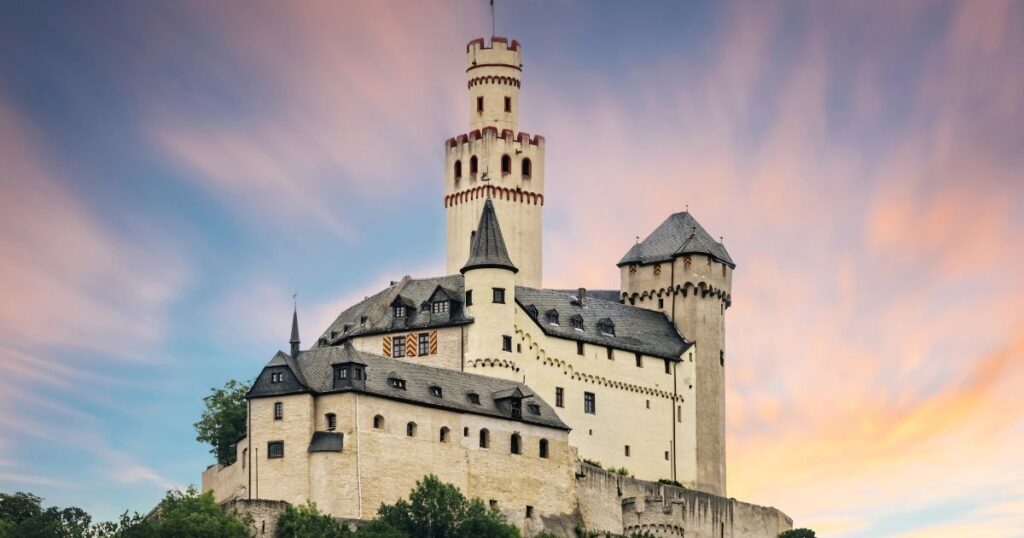
High Medieval & Gothic Expansion (13th–15th centuries)
Population growth, trade expansion, and advances in warfare led to more sophisticated designs. This era introduced:
- Gatehouse complexes
- Drawbridges
- Multi-story residential wings
- Castle chapels
- Fortified baileys
Examples:
Burg Eltz • Cochem Castle • Hohenzollern (original medieval fortress)
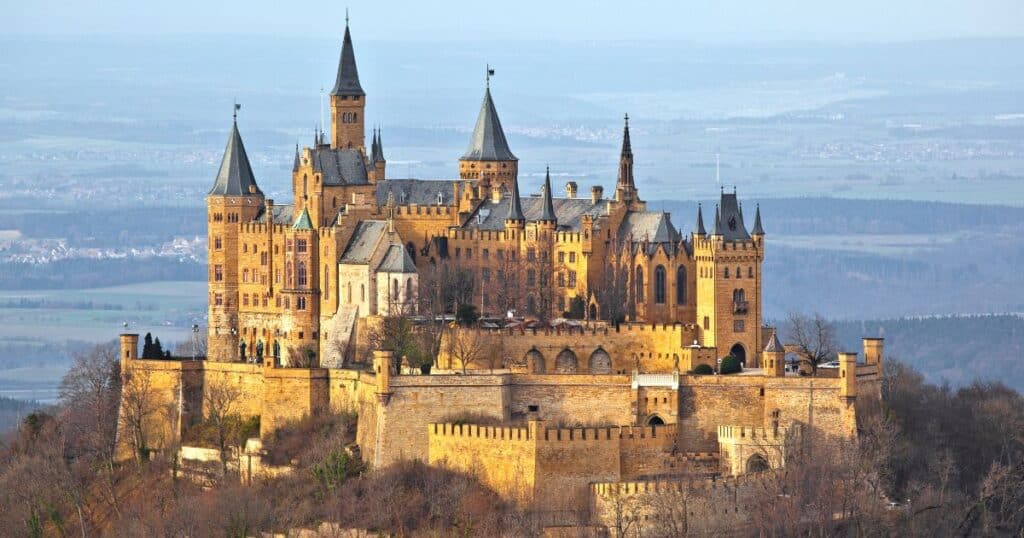
If you love the Gothic period, the Czech Republic is known for its Gothic fortresses and fairy-tale palace complexes.
Renaissance & Baroque Transformation (16th–18th centuries)
As firearms made high medieval walls obsolete, wealthy families shifted to comfort and grandeur.
Expect:
- Frescoed halls
- Grand staircases
- Marble reception rooms
- Ornamental gardens
- Dramatic facades
Examples:
Heidelberg Castle • Würzburg Residence (palace) • Charlottenburg Palace
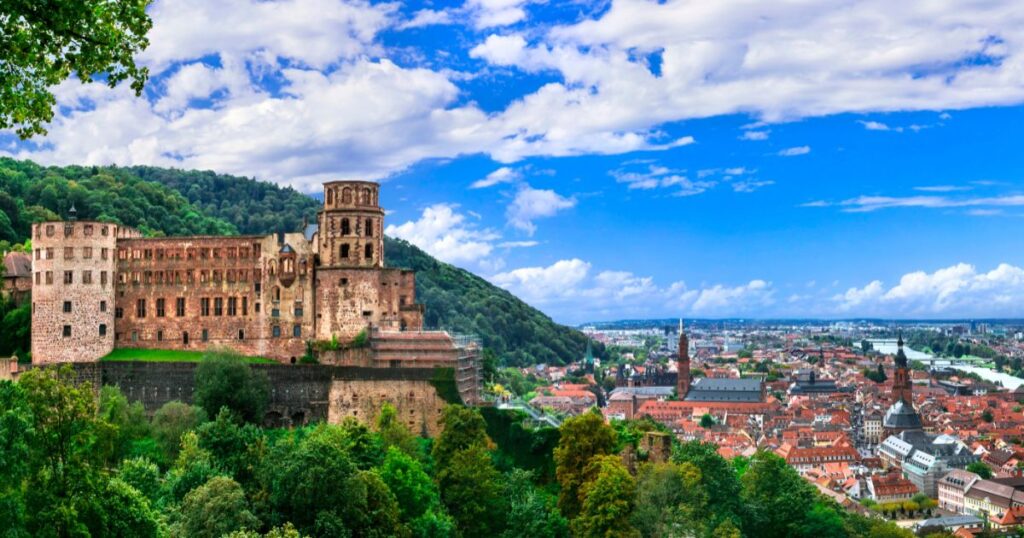
19th-Century Romantic Revival
Ludwig II and other aristocrats sparked a renaissance of fantasy architecture — not defensive, but expressive.
Elements include:
- Ornamental towers
- Fairy-tale silhouettes
- Mythic murals
- Wagnerian themes
- Dreamlike mountain settings
Examples:
Neuschwanstein Castle • Linderhof Palace • Hohenschwangau (revived interiors)
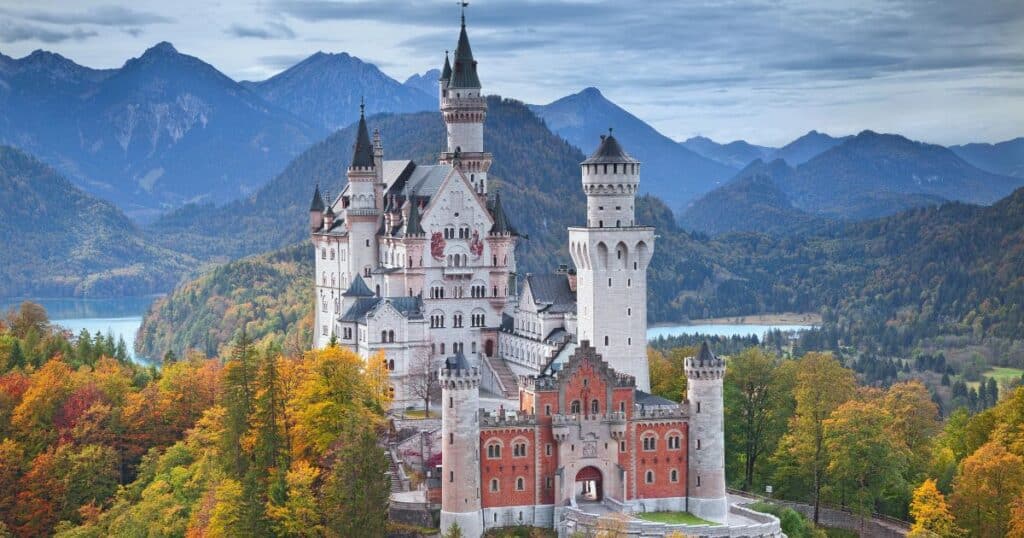
Today, Germany’s castles are carefully preserved through national foundations, UNESCO protection, private ownership, and regional heritage programs – giving travelers access to some of Europe’s best historic sites.
For travelers interested in broader European history, castles in Italy offer everything from Roman strongholds to ornate Renaissance courts.
Architectural Styles & Design Elements in German Castles
Germany’s castles span nearly a thousand years of design – from rugged medieval fortresses to glittering Rococo palaces. Here’s what travelers will notice as they explore:
Romanesque & Early Medieval (10th–12th centuries)
- Rounded arches
- Thick stone walls
- Fortress-like massing
- Sparse ornamentation
- Hilltop keeps for defense
Medieval Military Features (12th–15th centuries)
- Drawbridges & portcullises
- Murder holes
- Moats & fortified gatehouses
- Battlements and defensive towers
- Inner courtyards separating living and military areas
Gothic Enhancements (13th–15th centuries)
- Pointed arch windows
- Ribbed vaults
- Decorative buttresses
- Elaborate chapels
- Expanded noble apartments
Renaissance & Humanist Influences (16th century)
- Symmetry and classical proportions
- Frescoed halls
- Grand staircases
- More windows and natural light
- Cultural themes celebrating education, myth, and science
Baroque & Rococo Palaces (17th–18th centuries)
- Mirror halls
- Stucco ornamentation
- Marble and gilding
- Freshly designed palace gardens in geometric layouts
- Lavish ceremonial rooms and ballrooms
- Domed pavilions and ornate facades
Travelers to Germany frequently visit Austria next, drawn to its imperial palaces and Alpine fortifications.
19th-Century Romantic Revival (1800s)
- Turrets and fairy-tale silhouettes
- Picturesque mountain settings
- Wagnerian murals
- Storybook imagery
- Art-for-art’s-sake interiors
- A deliberate revival of medieval nostalgia
Fans of German castle architecture often fall in love with the iconic châteaux of France.
Famous Castle Regions in Germany
Germany’s castles cluster into distinct regions. These are some of the best ones to explore:
Bavaria (Southern Germany): Fairy-Tale Palaces & Alpine Landscapes
Bavaria is Germany’s most visited castle region — home to soaring mountain palaces and dramatic royal history.
Top Sites:
- Neuschwanstein Castle – Germany’s fairy-tale icon
- Hohenschwangau Castle – Ludwig II’s childhood home
- Linderhof Palace – A Rococo masterpiece
- Nymphenburg Palace – Munich’s grand baroque estate
Perfect for: first-time visitors, photography lovers, families, and anyone enchanted by romantic architecture.
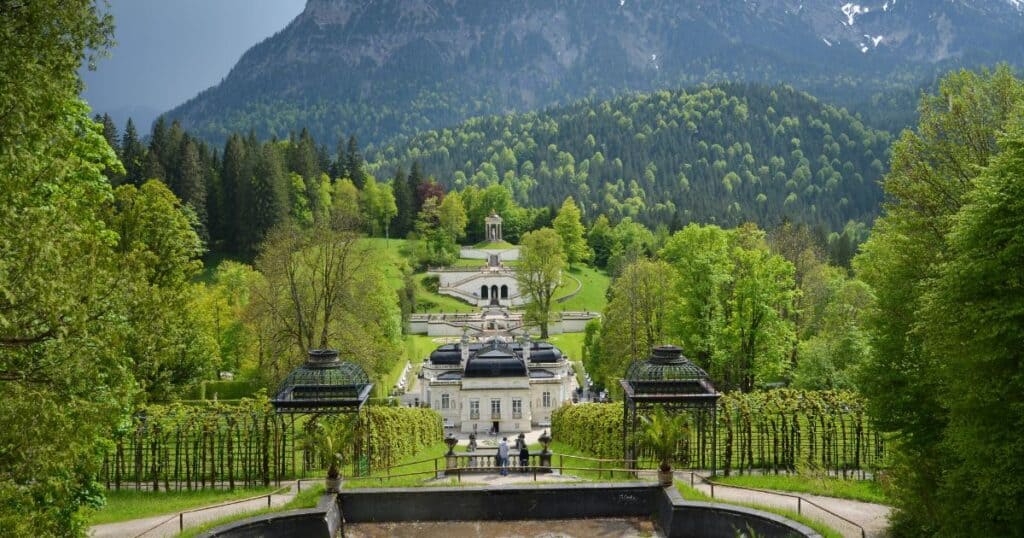
The Rhine Valley (Western Germany): River Castles & Medieval Strongholds
This UNESCO region delivers the highest concentration of dramatic medieval castles in Germany.
Top Sites:
- Marksburg Castle – Germany’s only hilltop castle never destroyed
- Pfalzgrafenstein Castle – A fortress on an island
- Schönburg Castle – Castle hotel opportunities
- Burg Rheinstein – Terraced gardens + epic views
Perfect for: river cruise travelers, wine lovers, medieval history fans.
If you’re exploring Germany’s scenic river valleys, the nearby Moselle is home to Cochem Castle, a storybook fortress with some of the best panoramic views in western Germany.
Berlin & Brandenburg (Eastern Germany): Prussian Palaces & Enlightenment Grandeur
This region is filled with palaces commissioned by Frederick the Great and later Prussian rulers.
Top Sites:
- Sanssouci Palace – Prussian Rococo jewel
- Charlottenburg Palace – Berlin’s largest royal residence
- Cecilienhof Palace – Where the Potsdam Conference was held
Perfect for: palace lovers, architecture fans, and travelers who enjoy gardens and culture.
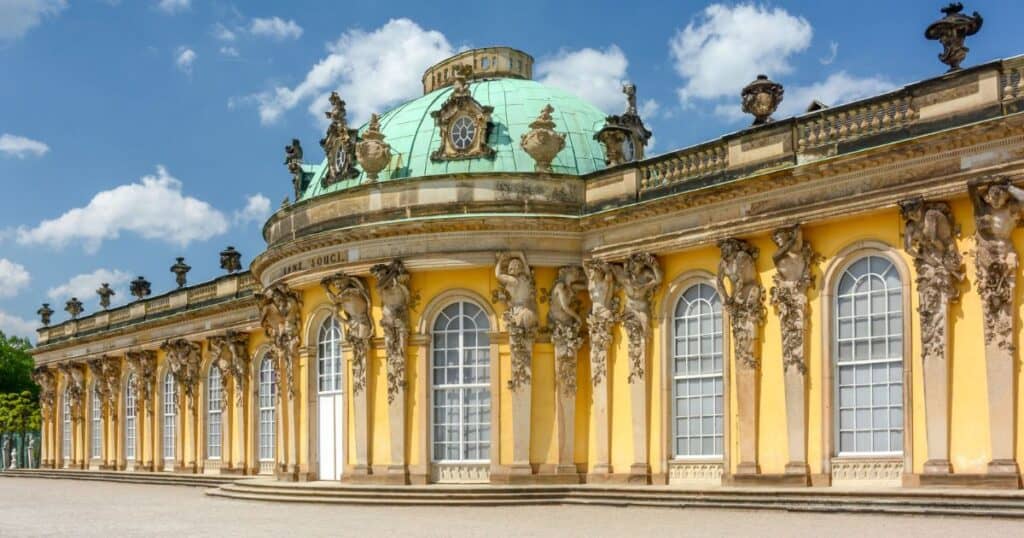
Northern Germany: Hanseatic History & Island Palaces
Known for red-brick Gothic architecture and lakeside residences.
Top Sites:
- Schwerin Castle – Often called “Germany’s Neuschwanstein of the North”
- Glücksburg Castle – Seat of the Danish royal family branches
Perfect for: travelers seeking castles outside the busiest tourist corridors.
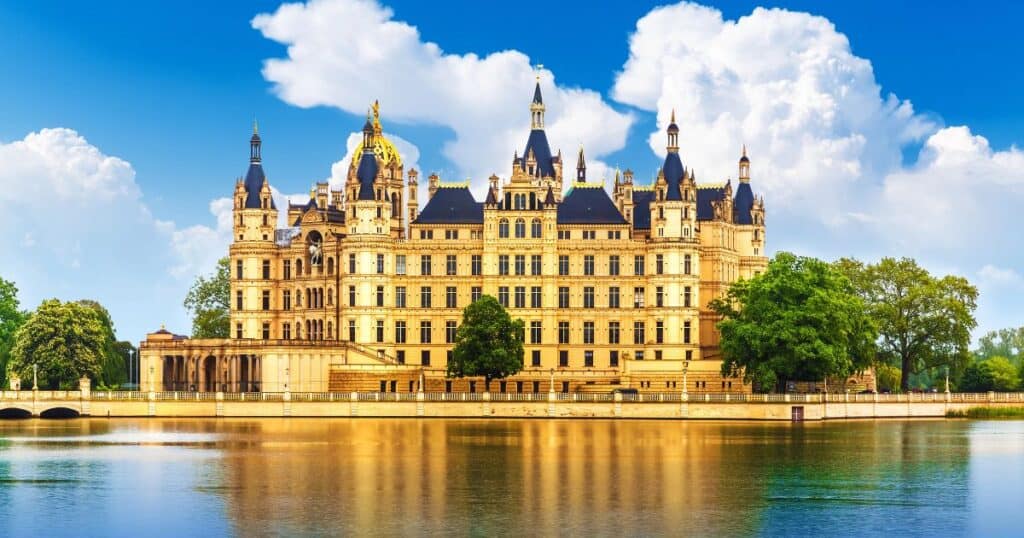
Central Germany: Castles of the Reformation & German Mythology
This region connects deeply to Martin Luther, Goethe, and German cultural history.
Top Sites:
- Wartburg Castle – Luther’s refuge; UNESCO
- Burg Eltz – One of the best-preserved medieval castles
Perfect for: history buffs, hikers, and architecture enthusiasts.
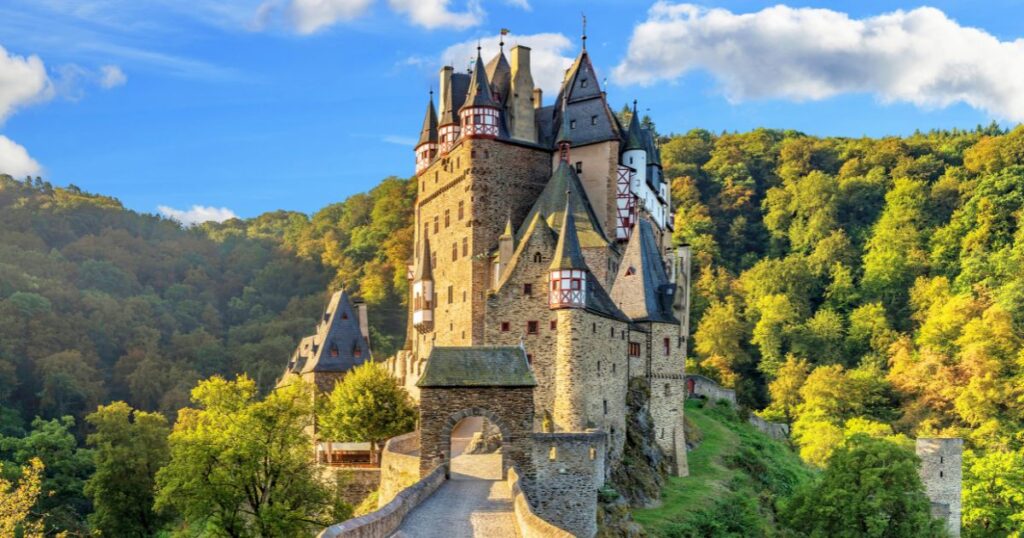
Saxony & Eastern Palaces: Baroque Brilliance
Not as internationally famous as Bavaria or the Rhine – but spectacular for palace lovers.
Top Sites:
- Moritzburg Castle – Lakeside hunting lodge of Augustus the Strong
- Dresden Castle – Home of the Green Vault treasures
- Pillnitz Palace – Riverfront summer residence
Perfect for: art enthusiasts, palace lovers, and history buffs.
If you enjoy European castle history, you may also want to explore castles in England, home to some of the most storied fortresses in the world. And, If you’re fascinated by fortress architecture, you’ll love exploring castles in Wales, home to some of the most dramatic coastal strongholds in Europe.
Top Castles to Visit in Germany
These selections blend fame, authenticity, and traveler experience. You can link each one to your individual castle post once updated.
Neuschwanstein Castle (Bavaria)
A fantasy palace built by Ludwig II – Germany’s most photographed landmark.
Marksburg Castle (Rhine Valley)
The only hilltop medieval castle never destroyed; interiors remain wonderfully authentic.
See full post: Marksburg Castle Guide
Sanssouci Palace (Potsdam)
A Rococo gem perched above sweeping gardens.
See full post: Sanssouci Palace Guide
Hohenzollern Castle (Baden-Württemberg)
A mountaintop fortress with royal treasures and spectacular silhouettes.
See full post: Hohenzollern Castle Guide
Heidelberg Castle (Baden-Württemberg)
Part ruin, part Renaissance masterpiece — famous for its romantic setting.
Burg Eltz (Rhineland-Palatinate)
Still owned by the same family after 800+ years, with remarkable medieval interiors.
Schwerin Castle (Northern Germany)
A lakeside palace straight out of a storybook.
Cochem Castle (Moselle Valley)
A dramatic hilltop castle overlooking vineyards and half-timbered towns. See my full Cochem Castle guide.
Wartburg Castle (Thuringia)
Luther translated the New Testament here – a UNESCO World Heritage treasure.
Linderhof Palace (Bavaria)
Small, lavish, and utterly theatrical – Ludwig II’s most refined residence.
Schloss Weikersheim
A hidden gem with extravagant gardens and some of the best-preserved Renaissance interiors in Germany. See my full Schloss Weikersheim Guide.
Moritzburg Castle (Saxony)
A gorgeous Baroque hunting lodge mirrored in a lake – famous from fairy-tale films.
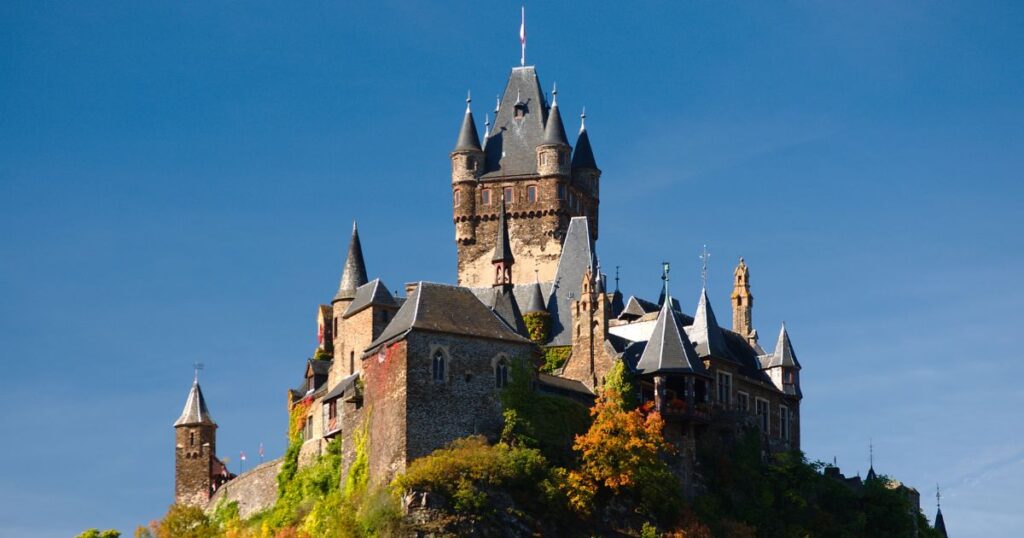
Castle Gardens & Landscapes in Germany
German castles often sit within expansive grounds perfect for walking, photography, and quiet exploration.
Garden Styles You’ll Encounter
- Formal baroque gardens (Sanssouci, Nymphenburg)
- Royal hunting parks (Charlottenburg)
- River-valley terraces (Rhine castles)
- Alpine vistas (Bavaria)
- Lakeside promenades (Schwerin)
Some estates – like Sanssouci and the Würzburg Residence – are world-class garden destinations in their own right.
Castle Restoration & Preservation in Germany
Many German castles survive thanks to centuries of careful stewardship:
- German Castle Association – Maintains Marksburg and others
- UNESCO – Protects key palaces and estates
- Private families – Maintain ancestral estates like Burg Eltz
- State and regional foundations – Restore palaces, chapels, and gardens
Travelers directly support preservation through ticket revenue – one of the most impactful ways to help protect these sites.
Notable Figures & Events
- King Ludwig II – Bavaria’s “Fairy-Tale King” and creator of Neuschwanstein, Linderhof, and Herrenchiemsee
- Frederick the Great – Philosopher-king of Prussia and master of Sanssouci
- Martin Luther – Took refuge at Wartburg and reshaped world religion
- The Hohenzollerns – Dynasty tied to the rise of Prussia and Germany
- The Thirty Years’ War – Destroyed countless castles; shaped German regional identity
Each castle carries centuries of stories – from royal ambitions to military strategy to artistic revolutions.
Castles in Modern German Culture
Today, Germany’s castles appear in:
- Films & TV series
- Travel photography
- Architectural studies
- Literary inspirations
- River cruise itineraries
- Dream-trip lists worldwide
Neuschwanstein famously inspired Disney’s Sleeping Beauty Castle, while Sanssouci remains a symbol of Prussian Enlightenment culture.
Planning Your Castle Tour in Germany
Germany is deceptively large – and castles run the full length and width of the country.
Suggested Themed Routes
Choose one or two routes per trip for a more in-depth experience region by region.
Fairy-Tale Route (Bavaria & Baden-Württemberg)
Neuschwanstein → Hohenschwangau → Linderhof → Hohenzollern
Rhine & Moselle Valley Route
Marksburg → Burg Eltz → Cochem Castle → Rheinstein → Schönburg
Berlin/Brandenburg & Prussian Splendor
Sanssouci → Charlottenburg → Cecilienhof → Peacock Island Palace
UNESCO Heritage Route
Wartburg → Würzburg Residence → Messel Pit (not a castle, but often combined) → Lorsch Abbey
If you like fairy-tale castles and coastal fortresses, you might consider Portugal, adds a Mediterranean flavor to a European castle itinerary. And for those exploring broader European history, Ireland offers some of the most atmospheric ruins and tower houses.
Practical Tips For Visiting Castles In Germany
Exploring castles in Germany is one of the most rewarding ways to experience the country’s landscapes, medieval heritage, and regional cultural traditions. These practical insights will help you plan efficiently, avoid crowds, and enjoy each castle at its best.
Trip Planning Essentials
Choose regions based on your interests
The Rhine and Moselle Valleys offer fairy-tale fortresses and riverside scenery, Bavaria features royal showpieces like Neuschwanstein and Linderhof, and northern Germany shines with lakeside palaces like Schwerin and Prussian elegance around Berlin and Potsdam.
Getting around
Germany’s public transport is excellent, with many castles reachable by train and bus. A car offers more flexibility for hilltop fortresses, panoramic viewpoints, and lesser-known sites.
When to visit
May–October offers the best weather, gardens, and long daylight. December brings enchanting Christmas markets at castles like Wartburg and Heidelberg. Winter hours vary widely.
Book in advance
Neuschwanstein, Sanssouci Palace, and Burg Eltz often sell out in peak season and on weekends.
On-Site Advice & Insider Insights
Prepare for varied terrain
Expect cobblestones, wooded trails, steps, and uphill approaches — sturdy footwear makes a big difference.
Photography considerations
Interiors sometimes restrict flash or photography, but many of the best shots are taken outside the castle – fog around Burg Eltz, sunset behind Hohenzollern, or lake reflections at Schwerin.
Weather tips
The Rhine can be humid in summer, Bavaria can get warm, and northern regions tend to be breezy. Bring layers, water, and sun protection.
Crowds & timing
Neuschwanstein and Burg Eltz are busiest midday; morning or late afternoon offers a more relaxed experience.
Food & facilities
Large palaces usually have cafés, while rural fortresses may have limited amenities. Many castles, especially along the Rhine, have lovely picnic spots.
Accessibility
Choose Nymphenburg, Charlottenburg, Sanssouci (especially the gardens), or Schwerin for easier access. Hilltop sites like Hohenzollern, Burg Eltz, and Wartburg require more physical effort.
Family-friendly options
Cochem Castle, Burg Eltz, and Neuschwanstein offer engaging tours, wide open spaces, and dramatic views that appeal to children.
Frequently Asked Questions About Castles In Germany
How many castles are there in Germany?
Germany is home to more than 20,000 castles, palaces, and manor houses, making it the most castle-dense country in Europe.
What is the most famous castle in Germany?
Neuschwanstein Castle is the most famous – known worldwide for its fairy-tale appearance and Disney inspiration.
Which German castle has the most authentic medieval interior?
Marksburg Castle is the only medieval hilltop castle in Germany that was never destroyed, making it the most accurate medieval interior to visit.
What is the best time of year to visit German castles?
May – October is ideal for gardens, river valley views, and long daylight. Winter is quieter but some castles close or operate on reduced hours.
Do I need tickets in advance for castles in Germany?
For popular sites like Neuschwanstein, Sanssouci, and Burg Eltz, advance tickets are strongly recommended, especially in summer.
Are German castles accessible for seniors or travelers with mobility issues?
Many palaces (like Nymphenburg, Charlottenburg, and parts of Sanssouci) are more accessible. Medieval castles – steep paths, cobblestones, and narrow stairs – can be challenging.
What is the best region to see lots of castles in one trip?
The Rhine Valley offers the highest concentration, followed by Bavaria for fairy-tale palaces and Brandenburg for Prussian royal residences.
Can I stay overnite in a real German castle?
Yes – several castles operate as castle hotels, especially along the Rhine and Moselle rivers.
What is the oldest castle in Germany?
Candidates include Meersburg Castle and Dankwarderode Castle, both with origins in the early medieval period.
Conclusion
Germany’s castles are not just architectural landmarks – they’re chapters of a living story that spans kings, wars, poets, philosophers, and the dreams of entire dynasties. Whether you’re wandering through a medieval armory, climbing a romantic hilltop tower, or strolling through an Enlightenment-era garden, exploring the castles in Germany connects you directly with 1,000 years of European history.
Fans of German castle architecture often fall in love with the iconic châteaux of France.
From fairy-tale palaces in Bavaria to rugged fortresses overlooking the Rhine, Germany offers an unmatched variety of castle experiences. Use this guide as your starting point – and prepare for a journey filled with beauty, history, art, and unforgettable landscapes.

